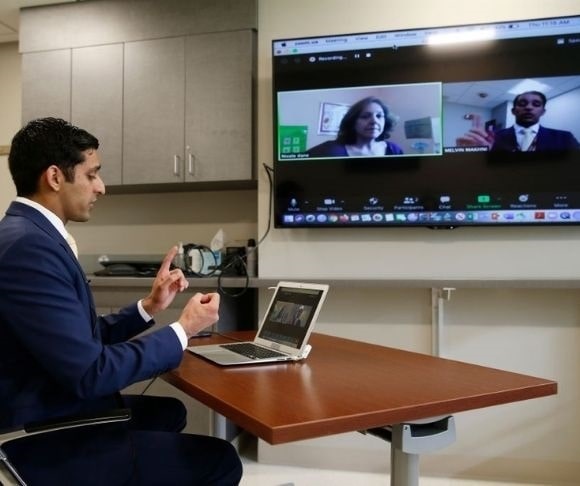Telehealth has existed for decades, but the coronavirus pandemic forced more hospitals, doctors, and patients to use this unconventional treatment method. The use of virtual visits rose from 2019 and through the pandemic, but whether it continues to trend upward beyond this year is unclear. Several bills have been proposed on Capitol Hill, but cybersecurity concerns and legally defining the purpose of telemedicine are the biggest obstacles standing in the way of expanding access. There are limitations to how much treatment one can get through a screen, but Americans are taking advantage of these manageable services.
What Is Telehealth?

(Photo by Dina Rudick/The Boston Globe via Getty Images)
The Iron Triangle of Healthcare concerns top priorities: cost, quality, and access. For the first time, this previously unbreakable ideal has been shattered. Our digital advancements have increased access and maintained quality without increasing cost.
Telehealth, or telemedicine, allows a doctor to provide care for a patient without an in-person office visit. Obviously, the experience is not the same, as the medical professional cannot listen to your breathing, draw a blood sample, check your ears and throat, and perform other necessary hands-on procedures. The most common care options include reviewing test results, mental health counseling, post-surgical follow-ups, treating recurring or skin conditions, managing prescriptions, and handling urgent issues such as stomachaches, colds, coughs, or COVID-19 symptoms. Consultations take place online via video conferencing, through a phone call, or on a live chat. It also allows doctors to monitor a patient remotely via a device that gathers vital signs and information.
According to Health and Human Services, there were 840,000 remote visits in 2019 for Medicare beneficiaries. In 2020, that number rose to 52.7 million. Specific subgroups of people have taken advantage of telehealth more than others. Since the pandemic started, the LGBTQ+ community is 25% more likely to utilize online care for mental health services than their non-member peers. Areas facing healthcare inequalities and a lack of access, where that Iron Triangle is most damaging, are also taking advantage of these online services.
According to a 2021 AARP study, telehealth adoption rates are highest in these communities that lack access to medical treatment. These areas predominately exist among people of color. This suggests that remote consultations are incredibly beneficial in overcoming barriers and disparities.
Health and Human Services also determined that 29% of women arranged a telemedicine appointment in 2020 instead of 19% of men. Of those who received virtual care, 88% said it was comparable to in-person or better, and 70% rated their mental health service online as “very good.”
Maintaining Trust
 Americans typically search for a primary care physician, dermatologist, gynecologist, cardiologist, or other medical experts they trust with whom to build a relationship. Telehealth appointments lack that personal connection. Medical services are not like a typical commercial transaction between strangers where the most significant risk lies in the mispricing of a good.
Americans typically search for a primary care physician, dermatologist, gynecologist, cardiologist, or other medical experts they trust with whom to build a relationship. Telehealth appointments lack that personal connection. Medical services are not like a typical commercial transaction between strangers where the most significant risk lies in the mispricing of a good.
The healthcare industry relies on trust. When a medical professional diagnoses or prescribes medication without running lab assessments typically done in person, it is harder for the patient to trust the doctor through a screen. Can telemedicine maintain that trust woven into the system? Or, as time goes on and normalcy returns, will folks return to in-person visits to guarantee more accurate treatment?
Cybersecurity Concerns
COVID-19-positive patients were sent home with technology capable of monitoring vital signs, heart rate, blood pressure, and other health data throughout the pandemic. All that information was collected and transmitted to a provider. One of the biggest concerns in this sector of telemedicine lies in cybersecurity. Milan Shah, CTO of Biofourmis, a company integrating technology into medicine, says “the minute you take some part of that technology (from a hospital) and send it home with a patient, suddenly you have to open up holes in your defense.” Network security cannot be guaranteed, and cybercriminals can attack an entire healthcare organization through a patient’s home internet.
Looking Forward
The future of telemedicine depends on some factors, including regulation. Restrictions were loosened during the pandemic to permit visits to cross state borders and via a phone call. But now, lawmakers must face a decision on how to handle virtual services moving forward.

(Photo by Jessica Rinaldi/The Boston Globe via Getty Images)
The House Ways and Means Health subcommittee recently introduced the Telehealth Extension Act, which Representative Elise Stefanik (R-NY) co-sponsored. It would lift geographic and location restrictions, allowing Medicare beneficiaries to access virtual care no matter where they live. Several similar bills have been introduced, mostly with bipartisan support, hinting that at least one will be passed. However, lawmakers’ sole decision is whether this service is an addition to traditional care or a substitute. That will dictate the language of a bill and how insurance companies and Medicare treat the provision.
Telemedicine became convenient for many folks working from home, watching their kids, or avoiding taking time off from work. There are obvious limitations to its capabilities. Although you cannot get an X-ray and cast for your broken wrist through Zoom, you certainly can have a follow-up appointment with your orthopedist. The entire industry’s pros are numerous, and experts don’t see it fading from healthcare. But how much it grows as the pandemic subsides is still unclear.
~Read more from Keelin Ferris.




